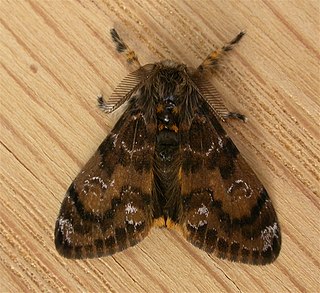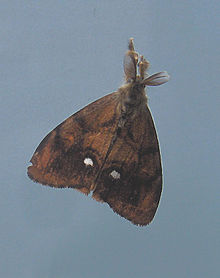
The Lymantriinae are a subfamily of moths of the family Erebidae. The taxon was erected by George Hampson in 1893.

Lymantria is a genus of tussock moths in the family Erebidae. They are widely distributed throughout Europe, Japan, India, Sri Lanka, Myanmar, Java, and Celebes. The genus was erected by Jacob Hübner in 1819.
Chlumetia is a genus of moths of the family Euteliidae. The genus was erected by Francis Walker in 1866.

Elusa is a genus of moths of the family Noctuidae erected by Francis Walker in 1859.

Episparis is a genus of moths in the family Erebidae erected by Francis Walker in 1857.
Hyperlopha is a genus of moths of the family Erebidae. The genus was erected by George Hampson in 1895.
Olulis is a genus of moths of the family Noctuidae first described by Francis Walker in 1863.

Paectes is a genus of moths of the family Euteliidae erected by Jacob Hübner in 1818.
Talapa is a genus of moths of the family Erebidae. The genus was erected by Frederic Moore in 1867.
Cispia is a genus of tussock moths in the family Erebidae. It was described by Francis Walker in 1855. They are found in India, Bhutan, Sri Lanka, China and southeast Asia.

Dasychira is a genus of tussock moths in the family Erebidae described by Jacob Hübner in 1809. They are well distributed all over Africa, Europe, North America, Madagascar, Japan, China, India, Sri Lanka, Myanmar, Java and Australia.

Euproctis is a genus of tussock moths in the family Erebidae described by Jacob Hübner in 1819. Species are cosmopolitan, widespread throughout Palearctic, African, Oriental and Australian regions. Molecular phylogenetic studies indicate that the genus as presently understood comprises a large number of unrelated lineages, only a few of which have names, and is therefore in serious need of revision.

Leucoma is a genus of tussock moths in the family Erebidae. The species are well distributed in Palearctic, Ethiopian, and Oriental regions along with New Britain and Ireland. It was described by Jacob Hübner in 1822.

Perina is a genus of tussock moths in the family Erebidae. It was described by Francis Walker in 1855 and is found in China, Sri Lanka and throughout India.

Teia is a genus of tussock moths in the family Erebidae first described by Francis Walker in 1855.

Derambila is a genus of moths in the family Geometridae first described by Francis Walker in 1863.

Fascellina is a genus of moths in the family Geometridae described by Francis Walker in 1860.
Urbona was a genus of moths of the family Nolidae erected by Francis Walker in 1862. It is now considered a synonym of Negeta.

Orgyia postica, the cocoa tussock moth or hevea tussock moth, is a species of moth of the subfamily Lymantriinae of the family Erebidae found in the Oriental tropics of India, Sri Lanka, Myanmar, Borneo, Java, New Guinea, and Taiwan. It was described by Francis Walker in 1855.

Spilosoma curvilinea is a species of moth of the family Erebidae. It was described by Francis Walker in 1855. It is found in Cameroon, Republic of the Congo, Democratic Republic of the Congo, Ghana, Ivory Coast, Kenya, Nigeria, Senegal, Sierra Leone, Sudan, Tanzania, the Gambia and Uganda.















